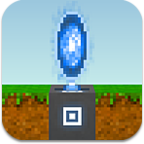Travel: Difference between revisions
>McClaw |
>McClaw No edit summary |
||
| Line 11: | Line 11: | ||
There may be a slight increase in apparent speed if a Blockhead is walking along a long series of one-block changes in height. This is most likely due to the horizontal and vertical speeds combining. | There may be a slight increase in apparent speed if a Blockhead is walking along a long series of one-block changes in height. This is most likely due to the horizontal and vertical speeds combining. | ||
==Crawling== | |||
'''Crawling''' substitutes for walking when a Blockhead must pass through a gap too short for it to travel upright. While a Blockhead is only two blocks tall, when walking up or down one block heights it will need an additional open block (above if going up, adjacent if going down) to avoid crawling. | |||
When crawling, a Blockhead's body is horizontal while its legs and arms are extended down and moving stiffly. In this position, its hands and feet are "inside" the block below although its true appearance can be seen in the [[User Interface|Character Status Icon]]. | |||
==Jumping== | ==Jumping== | ||
| Line 18: | Line 23: | ||
Vertical jumps will allow a Blockhead to reach a block above its head. | Vertical jumps will allow a Blockhead to reach a block above its head. | ||
==Climbing== | ==Climbing== | ||
Revision as of 18:37, 3 April 2013
A Blockhead will relocate its position through various forms of Travel depending on the terrain.
Overview
To make a Blockhead travel, tap a location one or more block spaces away from it's current position. An outline will appear at the new position and if the game can determine a path for the Blockhead to take, it will begin traveling there. If no path is found, the outline will disappear.
The game determines what route and methods of travel will be used, with the exception of riding or sailing which must be initiated by the player making a Blockhead use the appropriate equipment. If a specific path is desired, it may be necessary to select intermediate points along that route.
Walking
Blockheads moving across horizontal spans of solid block tops that are no more than one block different in height travel in a stiff-legged gait that may be called alternately Walking or Running. This is the basic (and possibly preferred) method a Blockhead uses.
There may be a slight increase in apparent speed if a Blockhead is walking along a long series of one-block changes in height. This is most likely due to the horizontal and vertical speeds combining.
Crawling
Crawling substitutes for walking when a Blockhead must pass through a gap too short for it to travel upright. While a Blockhead is only two blocks tall, when walking up or down one block heights it will need an additional open block (above if going up, adjacent if going down) to avoid crawling.
When crawling, a Blockhead's body is horizontal while its legs and arms are extended down and moving stiffly. In this position, its hands and feet are "inside" the block below although its true appearance can be seen in the Character Status Icon.
Jumping
A Blockhead can cross small gaps by Jumping. The maximum distance jumped appears to be one block, and may be vertical, horizontal, or both.
Horizontal jumps while walking seem just slightly slower than walking.
Vertical jumps will allow a Blockhead to reach a block above its head.
Climbing
If a Blockhead is traveling along the bottom surfaces of solid blocks or the vertical sides of two or more, or if using a ladder, it will climb. Blockheads are extremely capable climbers, never losing their grip and always finding a hand-hold.
When crossing a vertical rise (or drop) of two or more blocks, a Blockhead will make a one-block jump onto it and climb until it can safely make a one-block jump off. This means that for two-block climbs a blockhead will simply jump twice, clinging to a block between them. For greater distances, a Blockhead will make motions very similar to crawling but either up or down along the block sides.
The underside of blocks are no impediment to a Blockhead. When crossing a ceiling, a Blockhead will hang from its hands, slowly reaching forward before changing its grip and reaching with the other hand. Single block changes in height cause a Blockhead to lever itself closer using both arms before jumping slightly and grabbing the next surface with both hands. This is also how it transitions between a vertical climb and a ceiling climb.
A Blockhead climbing a ladder will face the ladder and travel up, down, or sideways as appropriate, its arms and legs moving similarly to crawling. Ladder climbing is about as fast as walking for vertical movement, but much slower horizontally.
Swimming
Swimming is the default way a Blockhead moves through water.
It's not as fast as sailing a boat.
Falling
Difficult to do.
Riding
Done on a donkey.
Sailing
Done with a boat.
